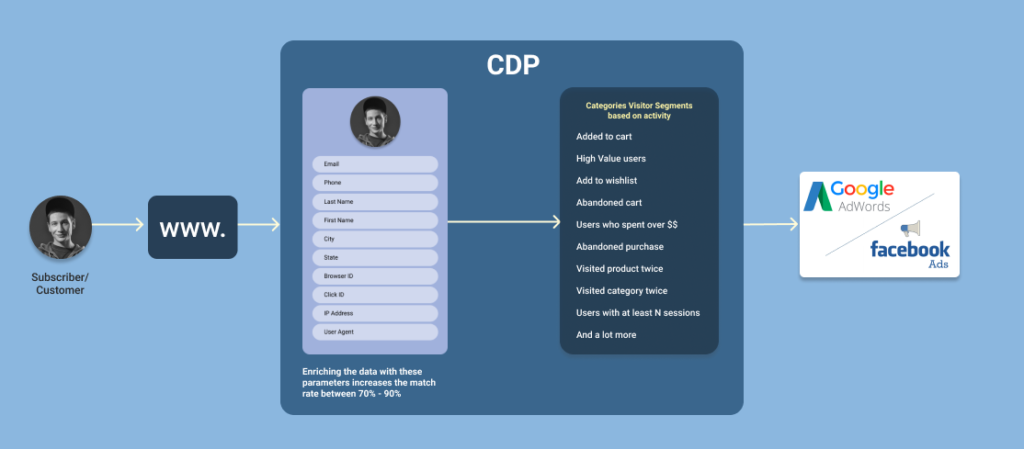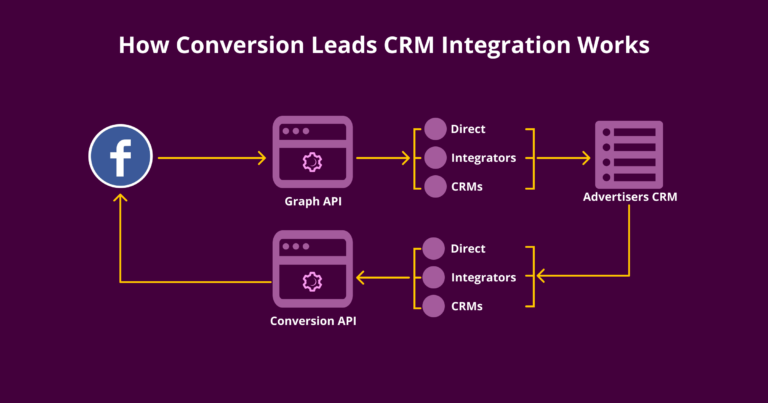Isn’t the digital marketers world the most dynamic in nature.
Everyday we woke up to see new changes and updates. One of the significant update in the digital advertising world is when Apple announced that in its next iOS’14 update, Apple intends to let users have more power over how their data is used. Users will have access to change the permission in device settings at any time.
That’s when marketers started discussing about Conversions API and Google Measurement Protocol to track their user’s behaviour.
Both Conversions API and Google Measurement Protocol, lets an advertiser to track and send your website data directly to Facebook and Google.
Yes, by implementing Conversions API can help solve attribution problems to an extent.
But why one has to “Go beyond Conversions API & GMP tracking”?
By 2022/23 third party tracking will go away! And Its gonna hit and drag the overall conversions rates.
First-party data holds the key to the solution…
Only the brands which collected their first party data will be able to drive growth, improve the ROAS and Customer LTV and deliver results.
Collect First Party Data – TODAY!
Like Sir Martin Sorrell says, 2020 is “the year of first party data.”
First party data is just not the signup form filled by the user with demographic details. First party data includes the data given by the user to the sales guy at the billing counter i.e. it can be T-shirt size which is unavailable or it could be taste preference in the food that they order. These informations also comprise the first party data which helps to build the profile.
Every data point that we collect from the users completes the 360 degree profile of the user.
According to the recent guide released by Google “The marketer’s playbook for navigating today’s privacy environment”, one of use case by Dominos will blow your mind on how and why every data point is important. By compiling the complete data of the online orders along with the CRM to pivot with the revenue generation, they found that 35% of the revenue was generated by the users who ordered twice in 30 days. This made domino focus more on digital advertising for this valuable group (to improve the LifeTime Value).
Now we have given the context and background of the talk of the hour. And now, we introduce you to Customer Data Platform and how it enables the marketer to produce great results.
Here you go,
First Party Data + Conversions API = Progressive Personalisation
Building 360 degree profile :
With 1PD Ops, we can now build the 360 degree profile of the users with all the possible first party data.
Creating Segments :
Marketers can segment the data based on categories like (Added to cart, High Value users, Abandoned cart, Visited product twice and various other custom-category segments based on your requirement).
Sync data with ad platforms:
With 1PD Ops, after segmenting the anonymous visitors data into various categories. You can sync the various segments along with their data parameters (Browser ID, Click ID, IP Address, User Agent, Facebook id, Google id, etc.) to Facebook and Google for advanced matching.
This lets Facebook match conversion events to your visitors helping algorithms improve the advertising performance.
Syncing data and beyond :
Traditionally the anonymous visitor data collected last only for 90 days on Facebook. Once the cookie data is removed by Facebook after 90 days you have to start building it from scratch and this process goes on forever.
With 1PD Ops, after building a 360-degree profile for anonymous visitors, the data will be synced with Facebook as an event everyday which lets the cookie data remain refreshed forever helping advertisers focus on important things like retargeting ads, optimizing them and increasing revenue rather spending time and money on bringing in visitor data alone.
Benefits of “Go Beyond Tracking Conversions” on various businesses:
For e-commerce businesses
A marketer cannot treat the user who visited your website and the user who purchased in the same campaign. Marketers can create as many cohorts required to re-target the anonymous visitors in Facebook and Google ads with the first party data and data tracked through Conversions API.
👉Convert your anonymous visitors to first time buyers
With 1PD Ops, marketers have access to more than 100 days old user data with which we can re-target them again by creating cohorts based on the website engagement to make them the first time buyers. This will improve the return on the ad spend (ROAS).
👉Increase the LifeTime Value of the Customers
You may have noticed that you have customers purchased once during a festival season or sale season which can be a few months before, say, 200 days ago..
With the purchase details and all the user parameters collected, we can now run ad campaigns relevant to the first time buyers and motivate them to buy again.

For Lead Generation Businesses:
By connecting CRM funnel data to Facebook Conversions API, marketers now can run and optimise conversion lead ads as well as conversion campaigns to generate qualified leads with a higher probability of conversion.
Steps to increase on Lead to Opportunity/SAL rate
👉Combine Website Engagement with CRM events
Unlike the traditional way, the newly generated leads can be synced directly with your CRM, so your sales team can take immediate action. The sales team can nurture the leads in real time with no extra time and manual work spent.
👉Optimise your campaigns for bottom of the funnel events with CRM data.
During the sales cycle, we may have crossed a lot of times where qualified leads fall cold. Most of the time those leads are left unattended.
But with 1PD Ops, we can create segments of those qualified cold leads and run relevant ad campaigns to rekindle and reactivate them. By which we bring them back to the active funnel and increase the pipeline revenue.
👉Let Facebook optimize your Lead Ad campaigns to get you more qualified leads by bringing CRM Funnel data.
With the CRM-Facebook Integration, we can seamlessly transfer lead data from CRM to Facebook in real time. This helps Facebook optimize the lead ad campaigns and focus more on bringing qualified leads who are likely to convert.

For Subscription Businesses
In subscription based businesses, Facebook won’t have access to month on month data of the subscriber purchasing history.
By integrating the billing systems with Facebook using 1PD Ops. Facebook can access month-month purchase history. This helps advertisers to evaluate the performance of ad campaigns by comparing the subscription data vs cost per lead.
As the result of the integration, campaigns can be optimized to provide higher LTV or for higher return on ad spend.




